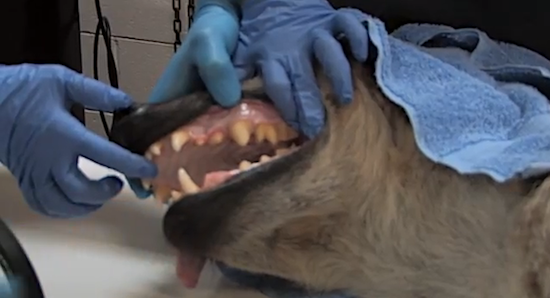From penguins to hyenas, vet students care for the wildest patients

A healthy but sedated hyena is examined by a team from the UW–Madison School of Veterinary Medicine and the Milwaukee County Zoo in a routine procedure for one of the zoo’s newest residents. The UW has one of only 22 accredited zoological medicine residency programs in the world, preparing students to treat exotic pets, zoo animals, and sick and injured wildlife.
It is a quiet Thursday morning in the clinic and the patient, sedated and with a baby-blue towel draped over her head, is wheeled into the examination room.
Quickly and expertly, the veterinary team rolls the patient, Nyota, a 120-pound spotted hyena, from steel gurney to exam table and begins hooking up a series of monitors and probes. Nyota, which means “star” in Swahili, is decidedly the star of the operation as a cone-shaped mask is fitted to her muzzle and a mix of oxygen and anesthesia ensures that one of the Milwaukee County Zoo’s newest denizens is ready for her quarantine exam.
“She is young and healthy,” observes veterinarian Sarah Churgin as she presses a stethoscope to the animal’s chest. A resident in the University of Wisconsin–Madison School of Veterinary Medicine’s zoological medicine program, Churgin and two fourth year UW–Madison veterinary medical students have traveled to Milwaukee this day to help with the routine work-up of an animal that most veterinarians will never encounter as a patient.
Laboring under the careful eye of Roberta Wallace, a senior zoo veterinarian with decades of experience, including 23 years at the Milwaukee County Zoo, Churgin and her UW–Madison colleagues help perform a blood draw, take Nyota’s blood pressure, administer a series of vaccinations, examine her eyes, mouth and extremities, and marvel at the hyena’s anatomy, which is remarkably different from that of a typical cat or dog patient.

An African penguin named Yellow, from the Racine (Wis.) Zoo, is prepped for a CT scan at the UW Veterinary Care Teaching Hospital. The unusual bird was found to have two fused vertebrae, but it is not a life-threatening condition and doctors say the patient will be fine. View a slide show with more photos of Yellow’s visit to the vet.
Photo: Bruce Fritz
“This is just so weird and cool,” says Kristin Nyren, one of the fourth year veterinary medicine students. “After graduation in May, I don’t know if I’ll ever have a chance to see a hyena again.”
Nyren may never again help give a hyena a physical, but there is no question that wherever she practices, she’ll meet up with many ailing animals that are not dogs and cats, or cows and horses.
“If you look at sheer numbers and you include fish, there are probably more exotic pets than dogs and cats,” explains Kurt Sladky, a professor of surgery and director of the school’s Zoological Medicine and Surgery Residency Training Program.
The UW–Madison initiative is one of only 22 accredited zoological medicine residency programs in the world, and its mission is to prepare veterinarians to effectively treat the increasing number of exotic pets, animals at zoos and aquaria, and injured and sick wildlife — and free-ranging wildlife as well. Sladky himself is one of only about 130 veterinarians in the world who is board certified in zoological medicine.
“The UW–Madison zoological medicine program, along with the Special Species Health Service, is the only veterinary residency training program in the entire Midwest that sees patients and is accredited by the American College of Zoological Medicine,” says Sladky. “We are one of the most diverse programs in the United States, offering a variety of exotic pet medicine, zoo species medicine and wildlife medicine. Most other programs focus on zoo and/or wildlife, but do not include exotic pets.”
“Part of what appeals to me about zoological medicine is that you really have no idea what is going to come through the door,” says Danielle Conway, a student rotating through the program, an option for all fourth year veterinary medical students at Wisconsin. “It forces you to think on your feet. It is not cookie cutter veterinary medicine.”
Patients can range from snakes and penguins to whales and elephants, although the typical exotic pet is most likely a bird or fish, or a small mammal like a rat or gerbil. But even invertebrates can benefit from veterinary care: Conway recently examined and treated a tarantula.
Conway explains that just knowing the basics about animals can be a key to effective veterinary care and treatment: “Most cases that walk through the door are diet or husbandry related. We see parrots and other animals, for example, when people feed them bizarre and inappropriate stuff.”
“Part of what appeals to me about zoological medicine is that you really have no idea what is going to come through the door. It forces you to think on your feet. It is not cookie cutter veterinary medicine.”
Danielle Conway
The program at UW–Madison depends on strong partnerships with organizations like the Milwaukee County Zoo, where residents in the three-year program work up to four months a year, and the International Crane Foundation in Baraboo, Wis., where residents work for six weeks a year.
The residency program at the Milwaukee County Zoo, funded by the Zoological Society of Milwaukee, was established in 2000, according to Wallace. “For the zoo, it helps us fulfill one of our primary missions, which is education. But the benefits are on multiple levels. We’re teaching future veterinarians, and having a program where they can be taught, mentored and coached is important.”
For Churgin, the act of performing a thorough physical on a large carnivore like Nyota is a microcosm of the challenges of working with exotic animals. The patients can be really big or really small. Knowing how to draw blood from an owl monkey or anesthetize and operate on a fish are skills that will be put to the test throughout her career.
The world of zoological medicine, notes Sladky, is rarefied. While veterinarians in routine practice may see injured wildlife or exotic pets as patients, cracking the world of zoos, aquaria and wildlife parks is a tall professional order.
“Everyone wants these residencies,” says Sladky, “because that’s the fastest track to board certification,” which is both a goal of the program and is greatly beneficial for anyone hoping to work in a zoo, aquarium or other institution that keeps exotic animals.
“And the program is helpful to our students no matter their career path,” Sladky argues. “Even if they are not interested in being an expert, they want to know how to handle any given situation, and our clinical service provides an opportunity to learn basic handling and diagnostic sampling of a wide variety of species. It is a great hands-on learning experience for a student.”


